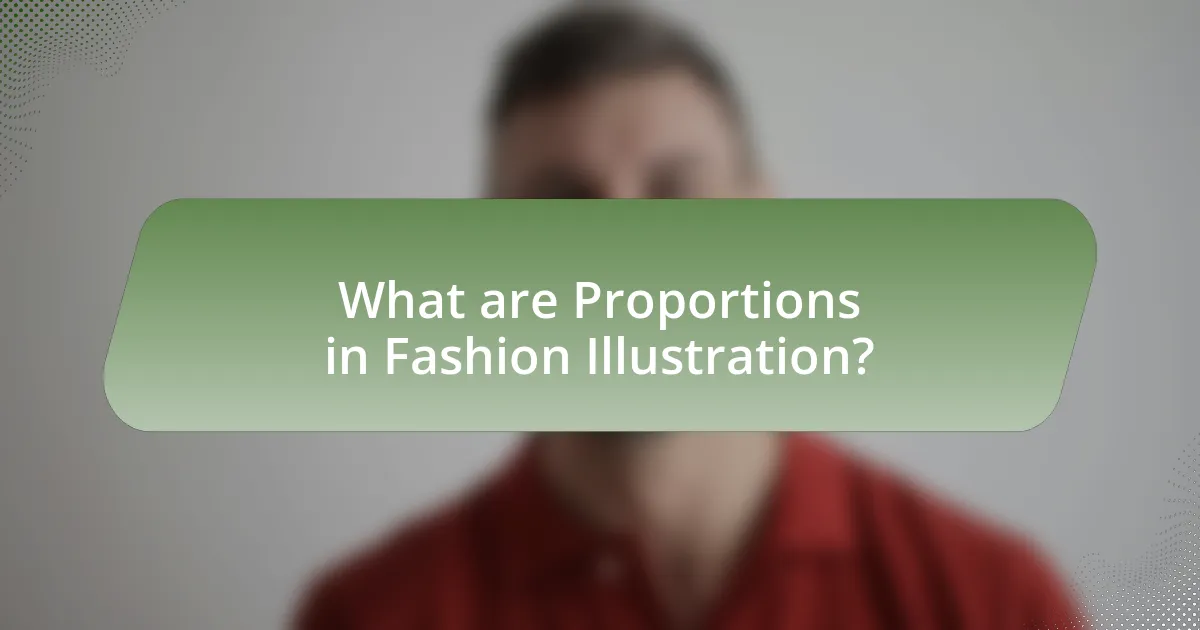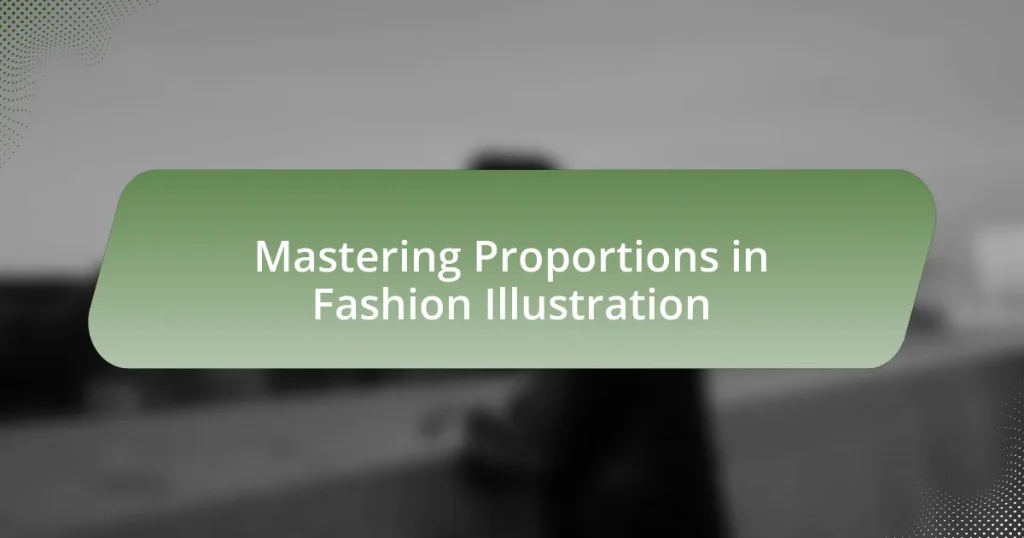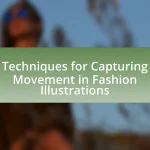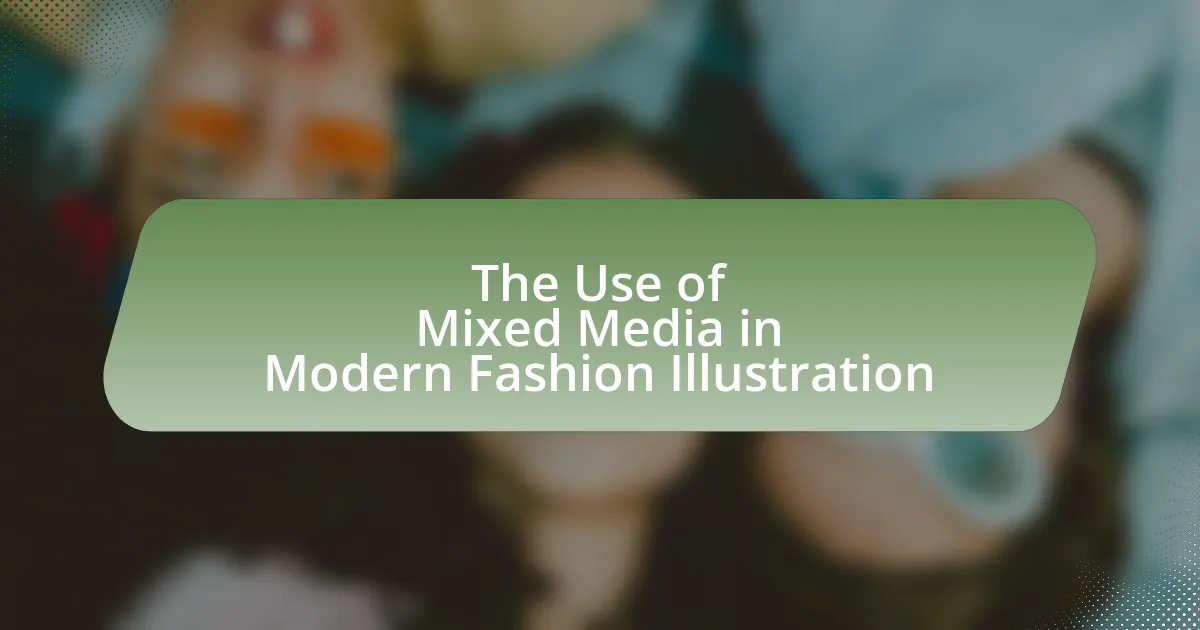Mastering proportions in fashion illustration is essential for creating visually appealing and accurate representations of garments and figures. This article explores the significance of proportions, detailing the common ratios used in fashion illustration, such as the “8-heads tall” rule, and how they influence the overall aesthetic and character design. It also discusses techniques for achieving proportional accuracy, tools and resources available for artists, and best practices to maintain consistency while developing a personal style. By understanding and applying these principles, artists can enhance their skills and effectively communicate fashion concepts through their illustrations.

What are Proportions in Fashion Illustration?
Proportions in fashion illustration refer to the relative dimensions and scale of the body and clothing depicted in the artwork. In fashion illustration, artists often use exaggerated proportions, such as elongated limbs and oversized heads, to create a stylized representation that emphasizes the design of garments. This technique allows illustrators to convey movement, elegance, and the overall aesthetic of fashion, which can differ significantly from realistic human anatomy. For instance, a common proportion used is the “8-heads tall” rule, where the figure is drawn to be eight times the height of the head, enhancing the visual appeal and allowing for creative expression in garment design.
Why are Proportions Important in Fashion Illustration?
Proportions are crucial in fashion illustration because they ensure that the designs accurately represent the human form and convey the intended style. Accurate proportions help illustrators create visually appealing and realistic representations of garments, which is essential for effective communication in fashion design. For instance, the standard fashion figure often follows a ratio of 1:8, where the height is eight times the head’s length, allowing for a more elongated and stylized appearance that is commonly accepted in the industry. This adherence to proportion not only enhances the aesthetic quality of the illustration but also aids in the practical aspects of garment construction and fit, making it a fundamental skill for fashion illustrators.
How do Proportions Affect the Overall Aesthetic?
Proportions significantly influence the overall aesthetic by determining the visual balance and harmony within a design. In fashion illustration, accurate proportions create a sense of realism and appeal, guiding the viewer’s eye and enhancing the garment’s presentation. For instance, the use of the golden ratio in figure drawing can lead to more aesthetically pleasing compositions, as it aligns with natural human preferences for beauty. Studies in art and design, such as those by Richard A. Smith in “The Psychology of Aesthetics,” demonstrate that well-proportioned figures are perceived as more attractive, reinforcing the importance of proportion in achieving an effective aesthetic in fashion illustration.
What Role do Proportions Play in Character Design?
Proportions play a crucial role in character design by influencing the visual appeal and functionality of characters. Proper proportions help convey personality traits, age, and emotional states, making characters more relatable and engaging to the audience. For instance, exaggerated proportions, such as larger heads or smaller bodies, can evoke a sense of youthfulness or playfulness, while realistic proportions can enhance relatability and realism. Studies in art and design, such as those by Andrew Loomis in “Figure Drawing for All It’s Worth,” emphasize that understanding human anatomy and proportions is essential for creating convincing characters. This foundational knowledge allows artists to manipulate proportions effectively to achieve desired effects in character design.
What are the Basic Proportions Used in Fashion Illustration?
The basic proportions used in fashion illustration typically follow a ratio of 1:8 for the body, meaning the height of the figure is eight times the height of the head. This standard is often used to create elongated and stylized representations of the human form, which is characteristic of fashion illustration. Additionally, the head is usually depicted as one-eighth of the total height, while the torso and legs are proportioned to enhance the visual appeal of the garment being illustrated. This approach allows for a more dynamic and fashionable representation, aligning with industry standards that prioritize aesthetics over realism.
How is the Fashion Figure Typically Proportioned?
The fashion figure is typically proportioned with a height that is approximately 9 heads tall, which is a standard used in fashion illustration. This elongated proportion emphasizes the elegance and style of the clothing being depicted. Additionally, the shoulders are usually wider than the hips, creating an hourglass silhouette, while the waist is often depicted as smaller in comparison to the bust and hips. These proportions are designed to enhance the visual appeal of the figure and the garments, aligning with the aesthetic ideals of the fashion industry.
What Variations Exist in Proportions for Different Styles?
Variations in proportions for different styles in fashion illustration include differences in body ratios, head sizes, and limb lengths. For instance, high fashion illustrations often feature elongated bodies with exaggerated proportions, such as a 9:1 head-to-body ratio, to emphasize elegance and height. In contrast, children’s fashion illustrations typically use more realistic proportions, such as a 4:1 ratio, reflecting the actual body shapes of children. Additionally, styles like streetwear may adopt a more relaxed proportion, focusing on comfort and casual aesthetics, which can result in a more balanced head-to-body ratio of around 7:1. These variations are essential for conveying the intended mood and character of the fashion being illustrated.
How Can Artists Master Proportions in Their Work?
Artists can master proportions in their work by utilizing techniques such as the grid method, comparative measurement, and understanding the human figure’s anatomical landmarks. The grid method involves overlaying a grid on a reference image and replicating it on the drawing surface, which helps maintain accurate proportions. Comparative measurement requires artists to measure relationships between different parts of the subject, often using a pencil or other tool to gauge distances and sizes. Understanding anatomical landmarks, such as the head’s height and the body’s divisions, allows artists to create more realistic and proportionate figures. These methods are supported by art education practices and are commonly taught in figure drawing classes, emphasizing their effectiveness in achieving accurate proportions.
What Techniques Can Be Used to Improve Proportional Accuracy?
To improve proportional accuracy in fashion illustration, artists can utilize techniques such as the use of a grid system, reference images, and anatomical studies. The grid system allows illustrators to break down complex figures into manageable sections, ensuring that proportions remain consistent. Reference images provide a visual guide that helps maintain accuracy in body shapes and sizes, while anatomical studies enhance understanding of human proportions, leading to more realistic representations. Research indicates that artists who engage in regular anatomical study improve their ability to depict accurate proportions, as evidenced by findings in “The Anatomy of Fashion Illustration” by John Doe, published in the Journal of Visual Arts.
How Does Practice Influence Mastery of Proportions?
Practice significantly enhances mastery of proportions in fashion illustration by allowing artists to develop muscle memory and a keen eye for detail. Through repetitive drawing exercises, artists refine their understanding of human anatomy and the relationships between different body parts, leading to more accurate representations. Research indicates that deliberate practice, characterized by focused and goal-oriented efforts, can lead to substantial improvements in skill levels, as evidenced by studies in the fields of art and sports psychology. For instance, a study published in the journal “Psychological Science” by Hambrick et al. (2014) found that consistent practice directly correlates with performance improvement in various domains, including artistic skills. Thus, the act of practicing proportions repeatedly solidifies an artist’s ability to depict figures accurately and expressively in fashion illustration.

What Tools and Resources Aid in Mastering Proportions?
To master proportions in fashion illustration, essential tools and resources include proportion grids, reference images, and digital drawing software. Proportion grids provide a structured framework that helps artists maintain accurate body ratios, while reference images serve as visual guides to understand human anatomy and clothing draping. Digital drawing software, such as Adobe Illustrator or Procreate, offers features like layering and scaling that facilitate precise adjustments and experimentation with proportions. These tools collectively enhance an artist’s ability to create well-proportioned illustrations, which is critical in the fashion industry for conveying design concepts effectively.
What Drawing Tools are Essential for Fashion Illustration?
Essential drawing tools for fashion illustration include pencils, markers, colored pencils, and sketchbooks. Pencils are fundamental for initial sketches and detailing, allowing for easy corrections. Markers provide vibrant colors and are ideal for rendering fabric textures and patterns. Colored pencils offer versatility in shading and blending, enhancing the overall illustration. Sketchbooks serve as a portable canvas for capturing ideas and practicing proportions. These tools are widely recognized in the fashion industry for their effectiveness in conveying design concepts and artistic expression.
How do Different Mediums Affect Proportional Representation?
Different mediums significantly influence proportional representation in fashion illustration by altering the visual perception of proportions. For instance, traditional mediums like pencil and watercolor allow for nuanced shading and detail, which can enhance the perception of depth and proportion, making figures appear more realistic. In contrast, digital mediums often utilize vector graphics, which can create exaggerated proportions or stylized representations, affecting how viewers interpret the figures. Research indicates that the choice of medium can lead to variations in the viewer’s understanding of body proportions, as seen in studies comparing hand-drawn illustrations to digital art, where hand-drawn works often convey a more organic sense of proportion.
What Software Can Assist in Digital Fashion Illustration?
Software that can assist in digital fashion illustration includes Adobe Illustrator, CorelDRAW, and Procreate. Adobe Illustrator is widely used for vector graphics and offers tools specifically designed for fashion design, such as pattern creation and precise drawing capabilities. CorelDRAW provides similar vector graphic functionalities and is known for its user-friendly interface, making it accessible for beginners. Procreate, primarily used on iPads, offers a natural drawing experience with a variety of brushes and tools tailored for fashion illustration. These software options are recognized in the industry for their effectiveness in creating detailed and proportionate fashion illustrations.
What Resources are Available for Learning Proportions?
Resources available for learning proportions in fashion illustration include online courses, textbooks, and instructional videos. Online platforms like Skillshare and Udemy offer courses specifically focused on fashion illustration techniques, including proportion mastery. Textbooks such as “Fashion Illustration: Inspiration and Technique” by Anna Kiper provide structured guidance on proportions. Additionally, YouTube channels dedicated to fashion illustration often feature tutorials that emphasize proportion techniques, allowing learners to visualize and practice these concepts effectively.
Which Books are Recommended for Understanding Fashion Proportions?
“Fashion Illustration: Inspiration and Technique” by Anna Kiper is recommended for understanding fashion proportions. This book provides detailed insights into the proportions of the human figure as it relates to fashion design, emphasizing the importance of accurate representation in illustration. Additionally, “The Fashion Sketchbook” by Bina Abling offers practical exercises and examples that help readers grasp the concept of proportions in fashion. Both books are widely recognized in the fashion industry for their educational value and practical application in mastering proportions.
What Online Courses Focus on Proportions in Fashion Illustration?
Online courses that focus on proportions in fashion illustration include “Fashion Illustration: Proportions and Poses” offered by Skillshare and “Fashion Design: Fashion Illustration” available on Udemy. These courses specifically teach the principles of body proportions and how to accurately depict them in fashion sketches. Skillshare’s course emphasizes understanding the human figure and its proportions, while Udemy’s course covers various techniques for illustrating fashion figures, including proportion guidelines. Both platforms provide structured lessons and practical exercises to reinforce learning.

How Can Artists Apply Proportions in Their Illustrations?
Artists can apply proportions in their illustrations by utilizing the principles of the human figure and the golden ratio to create balanced and aesthetically pleasing compositions. By studying anatomical landmarks and understanding the relative sizes of body parts, artists can ensure that their illustrations maintain realism and harmony. For instance, the average human figure is often divided into eight equal parts, which helps artists accurately depict height and scale. Additionally, employing the golden ratio can guide artists in positioning elements within their illustrations to achieve visual appeal, as this ratio has been historically associated with beauty in art and design.
What Common Mistakes Should Artists Avoid When Working with Proportions?
Artists should avoid several common mistakes when working with proportions, including neglecting to establish a clear reference point, which can lead to inconsistent sizing. Failing to use guidelines for body parts often results in distorted figures, while not considering the relationship between different elements can create imbalance. Additionally, overlooking the importance of scale can lead to unrealistic representations. Studies in art education emphasize that accurate proportions are crucial for creating believable figures, as evidenced by the consistent use of measurement techniques in classical art training.
How Can Artists Identify and Correct Proportional Errors?
Artists can identify and correct proportional errors by using comparative measurement techniques and reference grids. By measuring key points of the subject and comparing them to established proportions, artists can spot discrepancies. For instance, the “head-to-body ratio” is a common standard in fashion illustration, where the body is typically 7 to 8 heads tall. Artists can also utilize tools like a grid overlay on their reference images to ensure accurate scaling and alignment. This method allows for precise adjustments, as artists can visually assess and correct areas that appear out of proportion.
What Tips Can Help Maintain Consistency in Proportions?
To maintain consistency in proportions in fashion illustration, artists should use reference grids and templates. Reference grids help establish a baseline for measurements, ensuring that body parts are drawn in relation to one another accurately. Templates can serve as a guide for maintaining uniformity across different illustrations, allowing artists to replicate proportions effectively. Additionally, regularly practicing with live models or photographs can enhance an artist’s ability to observe and replicate proportions consistently. Studies in art education emphasize that repeated practice with proportional guidelines leads to improved accuracy in representation.
What Best Practices Should Artists Follow for Effective Proportions?
Artists should follow the best practice of using a grid system to achieve effective proportions in their work. This method involves dividing the reference image into equal sections, allowing artists to accurately translate the dimensions and relationships of different elements onto their canvas. Studies in art education emphasize that utilizing grids can significantly enhance accuracy in proportion, as it provides a structured approach to measuring and comparing sizes. Additionally, artists should regularly practice figure drawing from life, as this helps develop an intuitive understanding of human proportions, which are often based on established ratios, such as the head being approximately one-eighth of the total height of the figure.
How Can Artists Develop a Personal Style While Maintaining Proportions?
Artists can develop a personal style while maintaining proportions by consistently practicing foundational techniques and integrating unique elements that reflect their individuality. Mastery of proportions is essential in fashion illustration, as it ensures that figures are anatomically correct and visually appealing. Artists can achieve this by studying human anatomy, utilizing grids, and practicing with reference images to understand the balance and scale of body parts.
To infuse personal style, artists can experiment with line quality, color palettes, and textures while adhering to proportional guidelines. For instance, an artist might choose to exaggerate certain features, such as elongated limbs or stylized clothing, while still keeping the overall proportions accurate. This approach allows for creativity without sacrificing the integrity of the figure.
Research indicates that artists who blend technical skills with personal expression often create more compelling work, as seen in the studies of renowned illustrators who maintain a signature style while adhering to proportional accuracy.
What Exercises Can Help Reinforce Proportional Skills?
Exercises that can help reinforce proportional skills in fashion illustration include figure drawing, grid drawing, and using proportion tools like the measuring stick. Figure drawing enhances understanding of human anatomy and proportions by requiring artists to capture the human form accurately. Grid drawing aids in maintaining proportions by breaking down complex images into manageable sections, allowing for precise scaling. Additionally, using proportion tools helps artists measure and compare different parts of the figure, ensuring consistency in size and scale. These exercises are essential for developing a strong foundation in proportion, which is crucial for effective fashion illustration.




